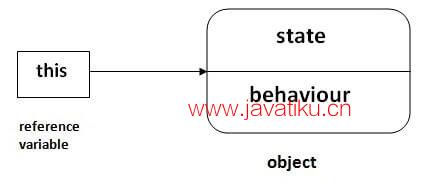Java教程-详解Java this 关键字

Java this关键字可以有很多用法。在 Java 中,这是引用当前对象的引用变量。

Java中的this关键字用法
以下是Java中this关键字的六种用法:
- this可用于引用当前类的实例变量。
- this可用于调用当前类的方法(隐式调用)。
- this()可用于调用当前类的构造函数。
- this可以作为方法调用中的参数传递。
- this可以作为构造函数调用中的参数传递。
- this可用于从方法中返回当前类的实例。
1)this:引用当前类的实例变量
this关键字可用于引用当前类的实例变量。当实例变量和方法参数之间存在歧义时,使用this关键字可以消除歧义。
理解没有使用this关键字的问题
让我们通过下面的例子来理解如果我们不使用this关键字会出现什么问题:
class Student{
int rollno;
String name;
float fee;
Student(int rollno,String name,float fee){
rollno=rollno;
name=name;
fee=fee;
}
void display(){System.out.println(rollno+" "+name+" "+fee);}
}
class TestThis1{
public static void main(String args[]){
Student s1=new Student(111,"ankit",5000f);
Student s2=new Student(112,"sumit",6000f);
s1.display();
s2.display();
}} 输出:
0 null 0.0
0 null 0.0在上面的示例中,参数(形式参数)和实例变量是相同的。因此,我们使用 this 关键字来区分局部变量和实例变量。
通过this关键字解决上述问题
class Student{
int rollno;
String name;
float fee;
Student(int rollno,String name,float fee){
this.rollno=rollno;
this.name=name;
this.fee=fee;
}
void display(){System.out.println(rollno+" "+name+" "+fee);}
}
class TestThis2{
public static void main(String args[]){
Student s1=new Student(111,"小安",5000f);
Student s2=new Student(112,"小宋",6000f);
s1.display();
s2.display();
}} 输出:
111 小安 5000.0
112 小宋 6000.0如果局部变量(形式参数)和实例变量不同,则不需要像下面的程序那样使用 this 关键字:
不需要此关键字的程序
class Student{
int rollno;
String name;
float fee;
Student(int r,String n,float f){
rollno=r;
name=n;
fee=f;
}
void display(){System.out.println(rollno+" "+name+" "+fee);}
}
class TestThis3{
public static void main(String args[]){
Student s1=new Student(111,"小安",5000f);
Student s2=new Student(112,"小宋",6000f);
s1.display();
s2.display();
}} 输出:
111 小安 5000.0
112 小宋 6000.0为变量使用有意义的名称是更好的方法。所以我们实时对实例变量和参数使用相同的名称,并且始终使用 this 关键字。
2)this:调用当前类方法
您可以使用 this 关键字调用当前类的方法。如果不使用 this 关键字,编译器会在调用方法时自动添加 this 关键字。让我们看看这个例子
class A{
void m(){System.out.println("hello m");}
void n(){
System.out.println("hello n");
//m();//same as this.m()
this.m();
}
}
class TestThis4{
public static void main(String args[]){
A a=new A();
a.n();
}} 输出:
hello n
hello m3) this() : 调用当前类的构造函数
this() 构造函数调用可用于调用当前类构造函数。它用于重用构造函数。换句话说,它用于构造函数链接。
从参数化构造函数调用默认构造函数:
class A{
A(){System.out.println("hello a");}
A(int x){
this();
System.out.println(x);
}
}
class TestThis5{
public static void main(String args[]){
A a=new A(10);
}} 输出:
hello a
10从默认构造函数调用参数化构造函数:
class A{
A(){
this(5);
System.out.println("hello a");
}
A(int x){
System.out.println(x);
}
}
class TestThis6{
public static void main(String args[]){
A a=new A();
}} 输出:
5
hello athis() 构造函数调用的实际用法
应该使用 this() 构造函数调用来重用构造函数中的构造函数。它维护构造函数之间的链,即它用于构造函数链接。让我们看看下面给出的示例,该示例显示了此关键字的实际用法。
class Student{
int rollno;
String name,course;
float fee;
Student(int rollno,String name,String course){
this.rollno=rollno;
this.name=name;
this.course=course;
}
Student(int rollno,String name,String course,float fee){
this(rollno,name,course);//重用构造函数
this.fee=fee;
}
void display(){System.out.println(rollno+" "+name+" "+course+" "+fee);}
}
class TestThis7{
public static void main(String args[]){
Student s1=new Student(111,"小安","java");
Student s2=new Student(112,"小宋","java",6000f);
s1.display();
s2.display();
}} 输出:
111 小安 java 0.0
112 小宋 java 6000.0规则:对 this() 的调用必须是构造函数中的第一条语句。
class Student{
int rollno;
String name,course;
float fee;
Student(int rollno,String name,String course){
this.rollno=rollno;
this.name=name;
this.course=course;
}
Student(int rollno,String name,String course,float fee){
this.fee=fee;
this(rollno,name,course);//CT错误
}
void display(){System.out.println(rollno+" "+name+" "+course+" "+fee);}
}
class TestThis8{
public static void main(String args[]){
Student s1=new Student(111,"小安","java");
Student s2=new Student(112,"小宋","java",6000f);
s1.display();
s2.display();
}} 输出:
Compile Time Error: Call to this must be first statement in constructor4) this: 在方法中作为参数传递
this 关键字也可以作为方法中的参数传递。它主要用于事件处理。让我们看看这个例子:
class S2{
void m(S2 obj){
System.out.println("方法被调用");
}
void p(){
m(this);
}
public static void main(String args[]){
S2 s1 = new S2();
s1.p();
}
} 输出:
方法被调用可以作为参数传递的 this 的应用:
在事件处理(或)我们必须提供一个类对另一个类的引用的情况下。它用于在许多方法中重用一个对象。
5) this: 在构造函数调用中作为参数传递
我们也可以在构造函数中传递 this 关键字。如果我们必须在多个类中使用一个对象,这很有用。让我们看看这个例子:
class B{
A4 obj;
B(A4 obj){
this.obj=obj;
}
void display(){
System.out.println(obj.data); //使用A4类的数据成员
}
}
class A4{
int data=10;
A4(){
B b=new B(this);
b.display();
}
public static void main(String args[]){
A4 a=new A4();
}
} 输出:
106) this关键字可用于返回当前类实例
我们可以将此关键字作为方法的语句返回。在这种情况下,方法的返回类型必须是类类型(非原始类型)。让我们看看这个例子:
可以作为语句返回的 this 的语法
return_type method_name(){
return this;
} 作为方法语句返回的关键字示例
class A{
A getA(){
return this;
}
void msg(){System.out.println("Hello java");}
}
class Test1{
public static void main(String args[]){
new A().getA().msg();
}
} 输出:
Hello java证明这个关键字
让我们来证明这个关键字引用了当前的类实例变量。在这个程序中,我们打印引用变量和 this,两个变量的输出是相同的。
class A5{
void m(){
System.out.println(this);//打印相同的参考ID
}
public static void main(String args[]){
A5 obj=new A5();
System.out.println(obj);//打印参考ID
obj.m();
}
} 输出:
A5@22b3ea59
A5@22b3ea59


